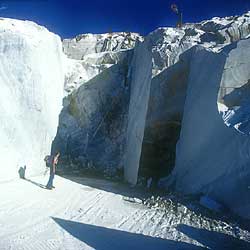|  If
tourists sunbathing on the beaches of Versilia and the Apuan coast turn
their backs to the sea, they can see the bastion of the Apuan Alps peremptorily
shutting off the view to the north-east. The white marks clearly visible
on the mountain slopes look like frozen snow shining in the rays of the
sun, but it is an optical illusion that is soon explained given that in
summer it does not snow in Tuscany. The distant shining whiteness is nothing
other than marble that has been extracted and brought to the surface,
and what seem to be permanent tongue-like snowfields are actually gigantic
masses of quarrying detritus tumbling down towards the valleys. Called
"ravaneti", they look like cascades of ice and descend the steep
slopes on which there also appear to be strange zig-zags. These are the
so-called Vie di lizza. Transporting the enormous blocks of marble from
the precipitous mountainside down to the valleys was an extremely arduous
task and often cost the lives of those who undertook it; tons of this
precious material were tied with ropes onto rudimentary wooden trolleys
called lizze, and, with wooden poles acting as brakes, were slowly lowered
down the mountainside. Once at the bottom they then went to embellish
houses all over the world or to be sculpted into beautiful statues. If
tourists sunbathing on the beaches of Versilia and the Apuan coast turn
their backs to the sea, they can see the bastion of the Apuan Alps peremptorily
shutting off the view to the north-east. The white marks clearly visible
on the mountain slopes look like frozen snow shining in the rays of the
sun, but it is an optical illusion that is soon explained given that in
summer it does not snow in Tuscany. The distant shining whiteness is nothing
other than marble that has been extracted and brought to the surface,
and what seem to be permanent tongue-like snowfields are actually gigantic
masses of quarrying detritus tumbling down towards the valleys. Called
"ravaneti", they look like cascades of ice and descend the steep
slopes on which there also appear to be strange zig-zags. These are the
so-called Vie di lizza. Transporting the enormous blocks of marble from
the precipitous mountainside down to the valleys was an extremely arduous
task and often cost the lives of those who undertook it; tons of this
precious material were tied with ropes onto rudimentary wooden trolleys
called lizze, and, with wooden poles acting as brakes, were slowly lowered
down the mountainside. Once at the bottom they then went to embellish
houses all over the world or to be sculpted into beautiful statues.
Nowadays marble quarrying is carried out using technologically sophisticated
equipment including steel cords and modern machines. Only in the last
few years have a number of environmental organisations begun to focus
on the issue of marble quarrying in the Apuans, with a call for limits
to be placed on the extraction of marble. Though undeniably useful to
the economy of the area, it is irreparably damaging mountains of a very
distinctive natural value. |